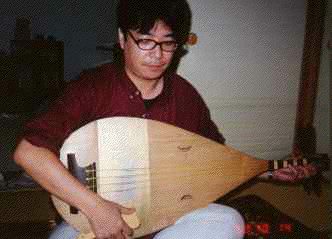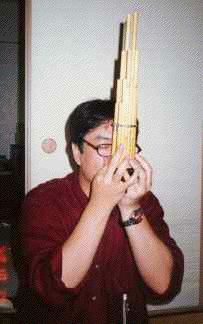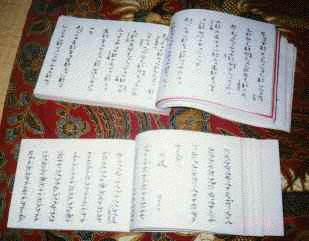Nakata Taizou rummages through Japan's cultural attic
by Tim Young
From SIF SATELLITE 52, Winter 1998-99
also appeared in Eye-Ai,
February 1999
 I
had a music teacher in college who said that, in terms of culture, "Japan
never throws anything away." That may be true, but it seems that a lot
of Japanese are unaware of a lot of what's stashed in the attic.
I
had a music teacher in college who said that, in terms of culture, "Japan
never throws anything away." That may be true, but it seems that a lot
of Japanese are unaware of a lot of what's stashed in the attic.
Take gagaku, for example, a musical form based on Chinese music that
has existed in Japan for at least 1400 years. I recently went to a large
department store in search of a gagaku CD. My initial search among the
traditional music CDs was fruitless, so I decided to ask one of the
shop clerks.
I approached a young woman in her early twenties, slightly chubby,
her hair dyed brown. When I asked her if they had any gagaku CDs, she
looked puzzled.
"Gagaku...," she repeated. I wasn't sure if she was just thinking,
or if she really didn't know what I was talking about.
"Old Japanese music," I added. Then the light went on in her face and
she knew which section to look in. (They didn't have any in stock, though;
I had to order one.)
To be fair, there aren't many people in any country who could tell
you anything at all about their local forms of music in the year 598.
The difference, however, is that, unlike most types of music from that
era, gagaku is still regularly performed; it has been called, "the oldest
continuous orchestral tradition in the world." And yet, there are Japanese
who don't even know what gagaku is.
"What is my native music?"
Nakata
Taizou used to count himself among this number. As a college student
in Osaka in the mid-1980s, he played in a rock band, and knew little
about the traditional music of his homeland. However, perhaps unusually,
this started to bother him.
"I was playing popular music," he says, "but one day I realized: I
was Japanese, but I didn't know Japanese instruments. Rock music is
native to America. I played rock. But I wondered, what is my native
music? So then, as I was looking for the answer to this question, I
discovered gagaku."
At age twenty, he quit university and moved to Tokyo to become a musician,
in spite of his parents' opposition to the idea. But his persistence
has paid off: he has learned to play the biwa and sho,
two gagaku instruments, and calls himself a "freelance gagaku musician."
Gagaku was traditionally played only within the Emperor's Court; before
the Meiji Restoration of 1868, commoners in Japan knew nothing of gagaku.
The Imperial Household gagaku troupe is still "the" gagaku troupe (the
CD I bought was recorded by them), but there are some, like Nakata,
who choose not join the Imperial Household. For one thing, it's very
restrictive: Imperial Household musicians cannot perform outside the
Imperial Troupe. Nakata's teacher is from the Imperial Household, and
Nakata could pass the test to join (which requires six or seven years
of study), but prefers to play at religious ceremonies, school demonstrations
of traditional instruments, and the like. (He spends the other half
of his time as a freelance computer software engineer; "It's impossible
to earn my living as a gagaku musician!" he smiles.)
Music for the Seasons
While demonstrating his instruments at schools, he met several other
musicians doing the same on other instruments. As a result, in early
1997 he formed a band, called T's Color, with koto player and vocalist
Hamane Yuka, bass kotoist Miyazaki Mieko, and Sakamoto Kazutaka on the
melodica, a keyboard instrument that is blown by the musician playing
it.
Along with the guitar, Nakata plays both of his gagaku instruments
in the band, but the band's repertoire is a far cry from gagaku; where
gagaku is ponderous and rather shrill, T's Color's music is made up
almost entirely of soft pop ballads. Their concert October 13 at Minami
Aoyama's Mandala live house consisted of gentle melodies, with layers
of beautiful, flowing koto playing. Before playing a tune called "Oyasumi"
("Good Night"), Nakata told the audience, "It's OK if you fall asleep!"
"We play pretty much quiet songs," he told me, "but we do have some
slightly more lively tunes." The liveliest one they played at Mandala
was "Harumachi Uta" ("Song of a Village in Spring"), a waltz-but, well,
a gentle waltz.
One of Nakata's compositions, Kiyose, is made up entirely of
seasonal words from haiku and tanka, he says. Naturally,
at the October concert, they played the "autumn version," - containing
such words as "hanano", a field of flowers, which Nakata says is an
autumn word from tanka - but there are different lyrics for the other
seasons. When asked if he often writes tanka or haiku, he's quick to
dispel that idea. "No, I don't!" he laughs. "Not especially. Just for
this song." Check the T's Color web site (http://www.zipangu.com/) for
further information.
One for the money, two for the sho
 One
intriguing aspect of T's Color is that the melodica and sho have a similar
sound quality, both having a reedy, somewhat nasal sound. The sho reminds
me, in both sound and appearance, of a tiny pipe organ. The bamboo pipes
of different lengths, clustered together, look like they belong within
a tiny replica of a European-style cathedral. The sho is played by covering
tiny holes, one at the base of each pipe, while blowing into the mouthpiece.
Only the pipes whose holes are covered will make a sound, so many different
combinations of chords can be played. This is something which is hard
to do very quickly, but as the sho's function in gagaku is to simply
play the same chords for long periods, as a canvas on which the oboe-like
plainhichiriki paints its melody, dexterity is not something
for which sho players strive.
One
intriguing aspect of T's Color is that the melodica and sho have a similar
sound quality, both having a reedy, somewhat nasal sound. The sho reminds
me, in both sound and appearance, of a tiny pipe organ. The bamboo pipes
of different lengths, clustered together, look like they belong within
a tiny replica of a European-style cathedral. The sho is played by covering
tiny holes, one at the base of each pipe, while blowing into the mouthpiece.
Only the pipes whose holes are covered will make a sound, so many different
combinations of chords can be played. This is something which is hard
to do very quickly, but as the sho's function in gagaku is to simply
play the same chords for long periods, as a canvas on which the oboe-like
plainhichiriki paints its melody, dexterity is not something
for which sho players strive.
Nakata disassembled his sho to, well, show me how it worked.
Each piece of bamboo has a tiny reed, like a clarinet's reed, waxed
to it. The reed may be removed, "but only for maintenance. It's kind
of a pain to take it off," Nakata says.
"If the reed gets wet," he goes on, "it won't vibrate." This is a real
concern, because moisture condenses easily inside the pipes. For this
reason, sho players have long kept their instruments in pots atop charcoal
braziers, to keep the instrument dry. Nakata, however, uses a more convenient
electric sho warmer!
Nakata pointed out that the various versions of the sho around Asia
have different sounds and are played differently. "The Japanese sho
has a very clear sound, but the (Chinese) sheng is like a horn-like
a trumpet, like the theme from Rocky!" Also, he points out, while Japanese
sit still when playing the sho, "the Vietnamese sho is played while
dancing!"
According to Bragard and deHen (see sources), the sheng originated
in present-day Laos and Cambodia. Due to increased contact between Asia
and Europe in the late 18th and early 19th centuries, the sheng found
its way west, where it inspired Berlin instrument maker Buschmann in
1822 to develop both the mouth harmonica and the accordion. Less directly,
she sheng also brought about the invention of the concertina, invented
in England in 1844.
We got the lute
The biwa, too, has cousins in the West. The earliest lutes date back
to at least 1700 BC, in Babylon or Egypt. A 3-string lute, resembling
the Asian tanbur, is reported by Bragard and deHen as having
been known in Europe in the 800s AD. An Arabian instrument called the
oud evolved into the Chinese pipa, then the biwa, as it
moved east, and became the lute, and later the guitar, as it was passed
along through North Africa to Spain and the rest of Western Europe.
Compared to the oud, however, the biwa is not as versatile, and especially
not the kind of biwa used in gagaku. Nakata explains that the oud has
eight strings, while the biwa has only three. Also, unlike the oud,
the biwa has frets, and is much flatter than, say, the lute, whose back
is a half-pear shape.
While the oud and its Western progeny are made of thin pieces of wood
put together, a biwa is made by hollowing out a solid piece of wood,
and then covering the hollow area with a separate piece. Although it
is semi-hollow and rather thin, it is also surprisingly heavy. According
to Nakata, his biwa weighs 6.5kg, while a non-gagaku biwa weighs 5kg.
(The koto, a larger but more completely hollowed-out instrument, weighs
in at 5 kg.) Nakata's biwa has a mahogany back with a covering piece
made of a type of mulberry wood, but he says the type of wood used varies
depending on the craftsman making the instrument.
Nakata demonstrated the way the biwa should be played in gagaku, using
a bachi to pluck all three strings sharply, harshly, bringing
the bachi to rest against the cowskin covering. "In gagaku, the biwa
is a percussion instrument," Nakata points out. This seems clear from
my CD, where the biwa never carries the tune; instead, the three strings
are plucked at crucial points, in the same manner each time.
Nakata showed us his written music for the biwa and sho. However, he
points out (as does Togi; see sources) that written music in gagaku
is more like a memorandum than actual sheet music; "it is useless unless
the performer has a solid background of training in the use of the instrument
and has memorized the piece beforehand," Togi writes, going on to say
that "the professional performer is required to memorize the whole repertoire."
Beauty in simplicity
Hundreds of years ago, gagaku was more improvisational, with more complicated
parts being played, particularly on the biwa. However, since these parts
were passed along by imitation and never written down, they were eventually
lost, making gagaku more simple and minimalist. This may not have been
completely accidental, however, since Japanese culture has often found
more beauty in simplicity.
I showed Nakata my CD, and he said it had a good selection of gagaku
compositions. He went on to explain that the titles of the pieces show
which "key" the piece is played in, although this is not a "key" in
the Western musical sense; two different "scales" may start with the
same note, but follow with different notes. Each of gagaku's six keys
has special meaning; for example, the key called Oshikicho means summer,
the phoenix, the heart, and the color red. It also signifies south,
and other keys are associated with west, east, and north; therefore,
according to Nakata, the temple bells in southern Kyoto are tuned in
Oshikicho, with the bells in western, eastern, and northern Kyoto tuned
in the keys associated with those directions!
Besides the difference in key, it's hard for non-gagaku experts to
find much difference between one gagaku composition and the next. There
is a rather set pattern for each piece-the flute begins, then percussion.
The sho then comes in playing a chord, and finally the hichiriki begins
the melody, with accompaniment by biwa and koto.
Being a gagaku musician got Nakata a chance to play in a movie. The
film, "Kaze no Katami," was set in Japan's Heian Era (794-857 A.D.)
"It wasn't a very good movie," he recalls with a smile. "It was an interesting
book, but the screenplay wasn't so good."
Nakata's wife is also a musician, playing the koto. He laughs, "since
we got married, we never perform together!" They now live in western
Tokyo with their one-year-old son.
I asked Nakata how people react when he tells them what he does for
a living. "Most of them are surprised," he says. "Most Japanese don't
know much about gagaku. They're surprised that there are any people
who still play gagaku."
Sounds like it's time to do some rummaging in the attic.
Sources:
Gagaku: Court Music and Dance, by Masataro Togi. Introduction by William
P. Malm. Weatherhill, New York & Tokyo, 1971
Gagaku/Music Department, the Imperial Household. Nippon Columbia Co.,
Ltd. 1991.
Musical Instruments in Art and History, by Roger Bragard and Ferdinand
J. deHen. The Viking Press, New York, 1968.
Global Sounds home


![]() This page last updated
December 27, 2003
. E-mail Tim
This page last updated
December 27, 2003
. E-mail Tim